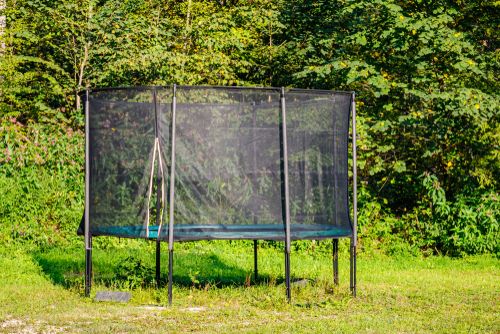In recent years, trampoline use has become a more popular recreational activity. Usage often occurs in back yards, jump parks, physical education classes, and more. Unfortunately, the number of injuries has grown with the increase in popularity.
With most trampoline injuries occurring on trampolines located at home, homeowners and trampoline owners are put at a greater risk for premise liability for any injuries that occur on their property. Should a homeowner be found liable for injuries that occurred on their property, the injured person may be able to recover compensation for medical expenses, lost wages, pain and suffering, and other losses through a personal injury claim.
Below we will explore common injuries, how to prevent these injuries, liability, and how to protect yourself as a homeowner.

Common Causes of Trampoline Injuries
Around 100,000 people have visits to the emergency room annually because of trampoline-related injuries. The majority of those occurring when there is more than one person jumping on a trampoline. Other common causes of trampoline injuries include:
- Bumping into or colliding with another jumper;
- Attempting to do stunts, somersaults, or flips;
- Landing improperly on the trampoline mat;
- Landing on the trampoline frame or springs;
- Falling or jumping off the trampoline etc and hitting a hard surface;
- Landing or stepping on exposed metal, springs, frame, etc.; and
- ‘Double-bouncing” yourself or another for added height.
Depending on the cause, force of impact, and landing, the severity of trampoline-related injuries will vary.
Types of Trampoline Injuries
Trampoline-related injuries can be as simple to recover from as small abrasions and cuts or can be as detrimental as paralysis and death. Fortunately, the most common trampoline injuries do not result in such severe suffering.
The most common trampoline injuries involve sprains and fractures to the arms and legs. Specifically, sprained ankles and broken arms occur the most often. In fact, children under the age of 16 suffer nearly 93 percent of fractures related to trampolines. Research has been conducted and found that young children have the highest risk of serious injuries from trampolines, including spinal and leg fractures. Young children make up around 37 percent of emergency room patients following a trampoline-related incident.
Other injuries include broken bones, sometimes requiring surgery; concussions and other head injuries; sprains/strains; bruises, scrapes, cuts; and head, neck, or spinal injuries which could lead to paralysis or death. While sprains and strains make up about forty percent of all trampoline injuries, about one in two hundred lead to permanent neurological damage.
The American Academy of Pediatrics (an organization of 60,000 primary care pediatricians, pediatric medical subspecialists, and pediatric surgical specialists dedicated to the health, safety and well-being of infants, children, adolescents, and young adults) cautions against any home trampoline use. The American Academy of Pediatrics urges pediatricians to advise parents against recreational trampoline use due to the associated risks.
Legal Liability for Trampoline Injuries
Homeowners can be found at fault when a trampoline-related injury occurs on the property. Liability for trampoline injuries are typically situation-specific, but a homeowner will be found liable for trampoline-related injuries if the homeowner was negligent, and the negligence was fundamental to the injuries that occurred.
Homeowners have a legal obligation to exercise a duty of care to the safety of visitors on the property. A breach of that duty creates a potential for the homeowner to be found negligent and therefore liable for any resulting damages or injuries. A property owner should take reasonable steps towards precautionary measures, such as making sure the trampoline is properly maintained and in good condition. A trampoline owner should also supervise any use of the equipment to ensure proper usage. For example, a homeowner should not allow young children to play on an older trampoline with springs exposed, play on a trampoline with no net, or use the equipment without supervision. Despite taking reasonable precautions, homeowners can still be found liable for negligence, which is why these types of cases are evaluated situation-by-situation.
Another form of liability that trampoline owners are at risk for is under the attractive nuisance doctrine. This doctrine states that landowners may be liable for injuries to children who trespass on their land if the injury results from a hazardous object or condition on the land that is likely to attract children who are unable to appreciate the risk posed by the object or condition. Trampolines and pools are often items on land that attract children and can result in danger. The American Academy of Pediatrics recommends that trampolines be treated like swimming pools, remaining inside closed off or well fenced off areas.
Homeowners should double check with their insurance company before purchasing a trampoline. Insurers are hesitant to provide coverage to homeowners who own trampolines due to the risk of trampoline injuries and the amount of trampoline-injuries that happen each year. If your insurance policy includes a trampoline exclusion and someone is injured on a trampoline at your home, your insurance will not cover the damages. This opens the door to potentially having to use your personal assets to cover damages of the injured party.
Additionally, by withholding information regarding your trampoline ownership from your insurance company, you put yourself at risk for a drive-by inspection by the insurance company. In such a case, some insurance companies will terminate a policy entirely without notice, and they reserve the right to do so.

Safety Tips for Trampoline Users
In an effort to reduce the amount of trampoline injuries, participants can take extra steps to avoid injury, including:
- Jumping one at a time on the equipment,
- Checking the equipment before using it, making sure the springs and metal is covered with proper padding and the net is properly attached
- Avoid attempting new skills, somersaults, and acrobatics
- Invite an adult to supervise the use of the equipment
Most of these safety tips are “common sense”; however, in the moment of excitement, these simple steps could be forgotten or overlooked. It is imperative that anyone who uses a trampoline put their health and safety before the fun of jumping.
For more information on how to prevent injuries, please visit the frequently asked questions section below.
Trampoline Injury Frequently Asked Questions
How many accidents are caused by trampolines?
On average, about 100,000 injuries occur yearly from trampoline-related accidents. Falls from a trampoline account for twenty-seven to thirty-nine percent of all injuries and can be potentially catastrophic.
How many people are injured on trampolines each year?
More than 1 million people went to emergency departments due to trampoline-related injuries between 2002 and 2011. Nearly 300,000 of these involved broken bones. Annually, about 100,000 people end up in emergency rooms from trampoline-related incidents.
How do you prevent trampoline injuries?
It is recommended that homeowners avoid owning trampolines at all, which would prevent injuries on the property. In fact, medical authorities advise against the use of home trampolines. However, if a homeowner already owns a trampoline, he or she should take reasonable safety precautions to prevent the likelihood of trampoline-related injuries and to reduce the likelihood of liability, including:
- Always supervise children using the trampoline
- Set up a trampoline enclosure such as a net to prevent falls
- Cover the springs, hooks, and frame with protective padding
- Do not allow young children on a trampoline with older children
- Set up the trampoline in an open area away from trees or other structures in the yard
- Do not allow or attempt somersaults on the trampoline, especially if there is more than one jumper on the equipment
- Do not place anything near the trampoline that could be used as a stepping ladder for small children to gain access to the trampoline without supervision
- Limit the amount of people on a trampoline to one person at a time
- Ensure spotters are present when participants are jumping
- Do not allow children under the age of six to participate in any jumping
- Consider investing in a fence around the property to prevent trespassers coming onto the property and inviting themselves ono the trampoline
- Purchase specific trampoline insurance coverage
If a homeowner insists on owning a trampoline, he or she could also consider placing a trampoline at ground level, minimizing the height of a potential fall.
Talk to a Professional
Trampoline injury liability varies depending on the circumstances surrounding the incident and the associated state law. Different rules govern for homeowner liability, trampoline parks, and other locations the trampoline was located at when a party was injured. If you have been injured on a trampoline or someone was injured on a trampoline that you own, it would be best to speak to a professional and discuss the facts of the situation to best understand your legal rights and obligations.
Contact the team at Batta Fulkerson Law Group today to schedule a FREE one-hour consultation to review your case and available options.
What to expect in your Consultation Meeting:
- Collection of information about you to help assist you better
- Review of any court documents
- Review of what happened in your claim
- Explanation of court processes, fees, and what we can do to help your case.
(619) 333-5555 Call Today or Book Online.




